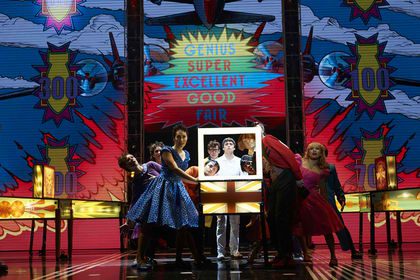See Me: Tommy at the Stratford Shakespeare Festival

Waiting For Godot isn’t the only show at Stratford this year that made me think of Gilbert and George. Indeed, the first connection I made was with the production of Tommy, directed by Des McAnuff (who, with Pete Townsend, created the original Broadway production).
Tommy, of course, is the story of a deaf, dumb and blind kid (played by Arden Couturier as a four-year-old, Joshua Buchwald as a ten-year-old, and Robert Markus as a young adult) who plays a mean pinball. That is to say: it’s the story about discovering rock music as a teenager in emotionally-repressed post-war middle-middle-class England, and suddenly waking up to the music and color of what had previously felt like an empty reality where the only thing you saw was your own reflection, and the only voice you heard was your own, because nobody else looked at or listened to you. And it’s a story about discovering one’s natural gift, and the disorientation that ensues when everyone else starts treating you very differently on account of that gift.
Structurally, the play is a bit problematic. In the movie, Tommy’s father doesn’t kill his wife’s lover – he is killed, accidentally. This Hamlet-ification was a change from the original album, but a felicitous one if you’re trying to motivate Tommy’s profound isolation. The stage version restores the original album’s story choice, but this leaves Captain and Mrs. Walker without much to do but fret about their son (since they don’t have nearly as serious a burden of guilt). The meaning of Tommy’s awakening remains obscure to me. His mother finally loses patience and smashes the mirror – and he wakes up. That’s it? So if she hadn’t been so solicitous all those years, he might have woken up earlier? And, finally, after his awakening, we get the rise and fall of the rock star – a story we’ve seen many times before. I appreciate that McAnuff doesn’t go all-in on the messianic overtones of the movie – his story stays at the level of celebrity culture – but the fact remains that this is an entirely new story arc that begins halfway through the second act and so needs to wrap up very quickly. We travel that story arc so quickly that we never really feel what Tommy is feeling.
Nonetheless, McAnuff tells the story he has very effectively. The music, which gets you out of your seat as well as it ever did, does a lot of the work. But he is also particularly blessed with three members of his cast: Jeremy Kushnier, as a frustrated and pained Captain Walker; Paul Nolan, channeling Malcolm McDowell in “A Clockwork Orange” (in attitude if not in costume) as Cousin Kevin; and, especially, Steve Ross, who delivers a tortured portrait of the dipsomaniac child molester Uncle Ernie that moves us to genuine sympathy for the poor man even as our skin crawls. His staging of both Cousin Kevin’s and Uncle Ernie’s abuse of Tommy remains very much on the PG-side, which blunts the horror of Tommy’s situation, but Nolan and Ross’s acting and singing are powerful enough to carry their respective moments nonetheless.

And then there’s the staging. My connection was Gilbert and George was visual first and foremost. McAnuff’s stage is dominated by a mammoth screen upstage on which he projects a variety of bold-colored images keyed to the themes of the play: doors, eyes, Union Jacks, etc. And the set and costumes are similarly bold and flat: Uncle Ernie in green, Captain Walker in blue, Cousin Kevin in red, the Walker house and furnishings all white (and Tommy attired all white as well). I think the intent was to echo the ’60s pop of Roy Liechtenstein, but what I saw was Gilbert and George’s faux stained glass windows – particularly when face after yellow face appears on the screen, crowded around Tommy’s house (for the “Come to This House” number). The key difference is that Gilbert and George took the pop aesthetic and turned it on themselves to transform themselves into pop icons.
I think that says something about our relationship with this material. The original album is very much an artifact of its time, utterly self-serious in the manner of Pink Floyd’s “The Wall.” It isn’t cool like pop art – it doesn’t have that ironic distance. But we do. We cannot think of rock (sublimated as pinball) as a revelation in and of itself; we’ve been living with this music for nearly fifty years now. When we act out this story, we’re self-consciously re-enacting a story that is now well-worn. We’re turning ourselves into icons.
We’re doing, in fact, what Tommy tells us not to do: trying to be like him. When all he wants is to be like us.
Tommy plays at the Stratford Festival’s Avon Theater through October 19th.
Comments